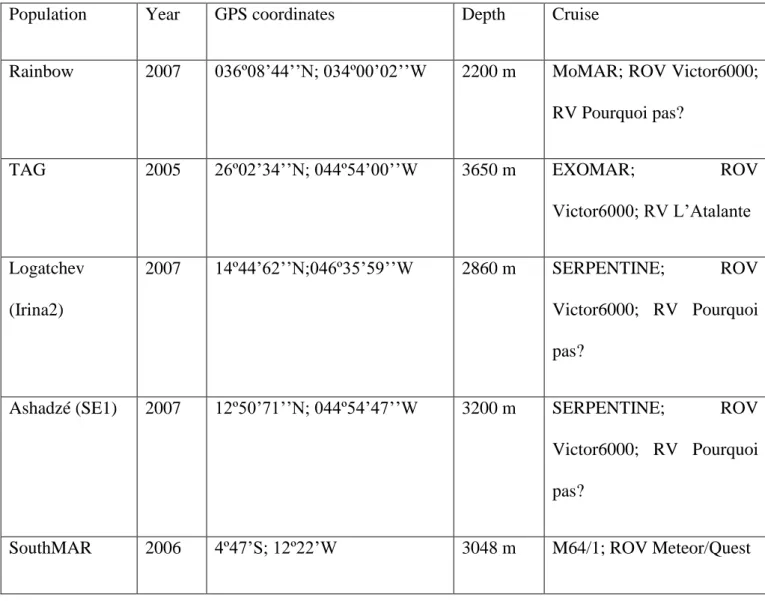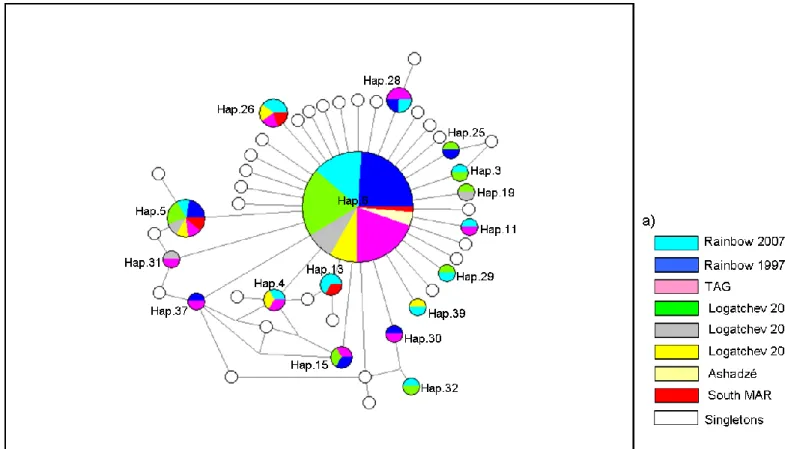Bachraty et al. Moalic et al. submitted) as well as of the rather high genetic differentiation found across about 3. Although hydrothermal vents at MAR have been known since 1985 (Rona et al. little is known about the population genetic structure of its most abundant shrimp species. To assess the 24 effect of potential temporal instability of hydrothermal activity and population dynamics of 1. associated species, two of the five studied populations were analyzed at time intervals of one or ten 2. Samples were collected from five locations corresponding to different hydrothermal vent fields 7. Rainbow , Logatchev, TAG, Ashadzé and South MAR) along the Mid-Atlantic Ridge (Fig.
2009). 18S rDNA (~1.7 kb) was amplified for 4 individuals from all sampled sites and years 11. with the exception of the Ashadzé population, where only three available individuals were amplified) using 12. For populations with significantly different sample sizes , a re-sampling method was 4. applied using R to generate files for 100 random re-samplings of the haplotype population 5. frequencies at a common minimum size.
Discussion
The life cycle of Rimicaris is poorly understood. exoculata can feed in the upper water column during larval dispersal 8. Dixon & Dixon, 1996), and others that the juvenile stages of these shrimp differ physiologically 9. However, such a hypothesis implies either a high risk factor in the case of 14. passive dispersal or an extremely a sophisticated mechanism of active and deterministic migration 15. which has not yet been identified) that allows return to the hydrothermal habitat at the end of the larva 16. Such geographic segregation of symbionts compared to host homogeneity may be due either to 14.
However, in the absence of any selective hypothesis to explain the stellate pattern of COI 16. Other species, however, do not show such splitting (Won et al., 2003; Hurtado et al. Plouviez et al., 2009), which may indicate a characteristic characteristic for a species (such as 6 . dispersal potential or population size) or may simply reflect different sampling schemes. Few species have been studied in MAR so far compared to the more extensively studied 16.
The putative mechanism that may allow R. exoculata larvae to establish in their habitat after this hypothetical long-distance dispersal is therefore 7. not elucidated, it may be temperature-associated or based on chemical signals linked to the presence 8 . of adults, as has been demonstrated for other marine invertebrates such as the oyster Ostrea 9. puelchana, where preferential settlement of spat occurs near the adults as a result of a chemical stimulus 10. This study makes a new contribution to our understanding of the biogeography of the Mid-Atlantic 12. Edge by providing new insight into the population biology and biogeographic structure of a key species of shrimp from the unique, extreme and remote marine habitats of hydrothermal vents. results indicate that, across this very remote biogeographic region, all vent populations of these shrimp 15. have a recent common history derived from a bottleneck or founder event, followed by a 16. demographic expansion to apparently large effective population sizes. dispersal potential, such history may lead to the absence of significant drift effects.
Interestingly, these results may indicate a possible common source or center of origin of a 19. re)colonization event at the origin of the lineages sampled from the MAR in our study.
Acknowledgements
Journal of the Marine Biological Society of the United Kingdom Genetic comparison of two populations of deep- 3. An overview of the distribution of hydrothermal vent communities along 15. the northern Mid-Atlantic Ridge: dispersal vs. 1996) Results of DNA analyzes performed. in vent shrimp postlarvae 17. collected above the Broken Spur vent field during the CD95 cruise, Aug. Isolation of plant DNA from fresh tissue. 2010) Microbial diversity associated with the hydrothermal vent shrimp Rimicaris 24. exoculata gut and the emergence of a resident microbial community. deep-sea benthic data with the Ocean Biogeographic Information System online. multi-locus analysis of divergence and gene flow between two hybridizing strains of 7. hydrothermal amplification of mitochondrial DNA from different invertebrate phyla. New statistical neutrality tests for DNA samples from a population. 1997) Statistical tests of neutrality of mutations against population growth, hitchhiking and 14. 2007).
Temporal change in megafauna at the Rose Garden hydrothermal vent (Galapagos Rift; eastern 2nd tropical Pacific). 2004) Distinct patterns of genetic differentiation among 6th annelids of hydrothermal vents in the eastern Pacific. 2000) Spatial synchronization of mussel population dynamics with 8. New age data for hydrothermal sites in the Mid-Atlantic Ridge: TAG and Snakepit chronology revisited. 2000) Reproductive biology of three caridean shrimps, 1. Rimicaris exoculata, Chorocaris chacei and Mirocaris fortunata (Caridea: Decapoda), from 2. Journal of the Marine Biological Association of the United Kingdom hydrothermal sediment and experimental microcolonizers at the Mid-Atlantic Ridge.
Geographic clines and stepping stone patterns detected along the East Pacific Rise in the 9. vetigastropod Lepetodrilus elevatus reflect species cryptism. 1995) Metapopulation genetics and the evolution of 12. 2007) Temperature control of larval dispersal and its implications for marine ecology, evolution, 15. Double symbiosis of the pin shrimp Rimicaris exoculata with filamentous gamma and 24. epsilonproteobacteria on four Mid-Atlantic Ridge hydrothermal vent fields. 1997) Wax ester reserves facilitate the spread of hydrothermal vents 3. 2009) Comparative phylogeography among hydrothermal vent types along the eastern Pacific Rise 6. reveals vicariance processes and population expansion in the south.
Statistical properties of new neutrality tests against 9. 2003) Intra-deme molecular diversity in spatially expanding 11. massive sulfides and vent biota on the Mid-Atlantic Ridge. Laboratory of Genetics and Biometry, Department of Anthropology, University of 2. Shrimps Alvinocarididae in hydrothermal areas along the Mid-Atlantic Ridge. 1983) Evolutionary relationships of DNA sequences in finite populations. 1989) Statistical method for testing the neutral mutation hypothesis by DNA 16. 1996).
The amount of DNA polymorphism retained in the final population when the neutral mutation rate 18 varies between sites. 1991). 1996) Impact of seafloor spreading on global hydrothermal 22. 1999) Propagation and spreading at vents and cold springs. UK Association of Marine Biology Mid-Atlantic Ridge Hydrothermal vent ecology. 2000) Ecology of deep-sea hydrothermal vents. Gene flow and genetic diversity in naturally fragmented metapopulations of 12. deep-sea hydrothermal vent animals.
Supporting information
1999) Propagation and spread along vents and cold flows. UK Association of Marine Biology Mid-Atlantic Ridge Hydrothermal vent ecology. 2000) Ecology of deep-sea hydrothermal vents. As a service to our authors and readers, this journal provides supporting information provided by 6. Such materials are peer-reviewed and may be edited for online delivery, but are not 7.
Technical support issues arising from supporting information (other than 8. missing files) should be directed to the authors.
Biosketches
Segment size is proportional to the 6 . relative frequency of a haplotype in each population where it is present. a) Color key to the 7.







